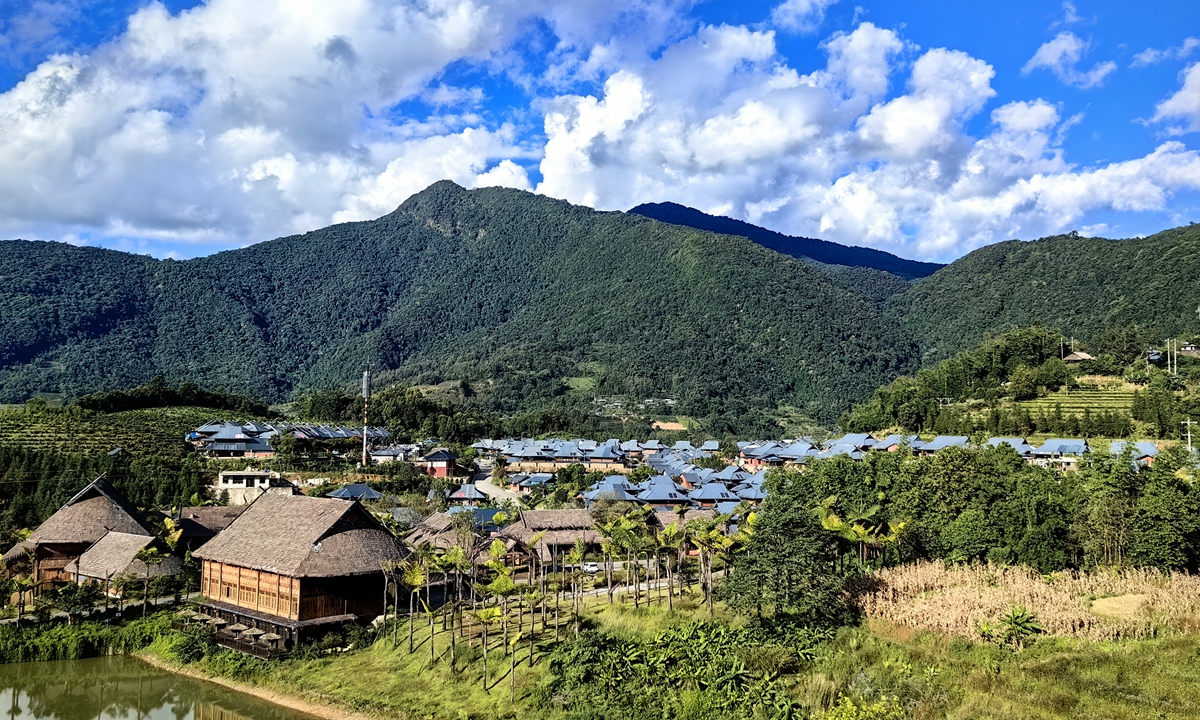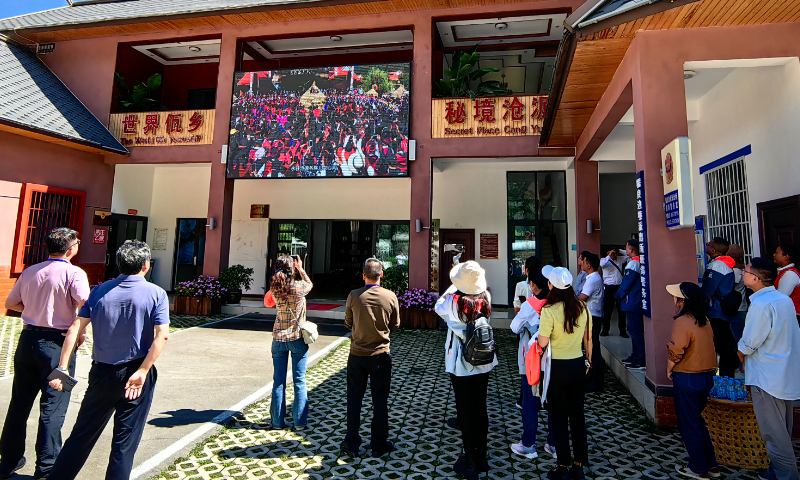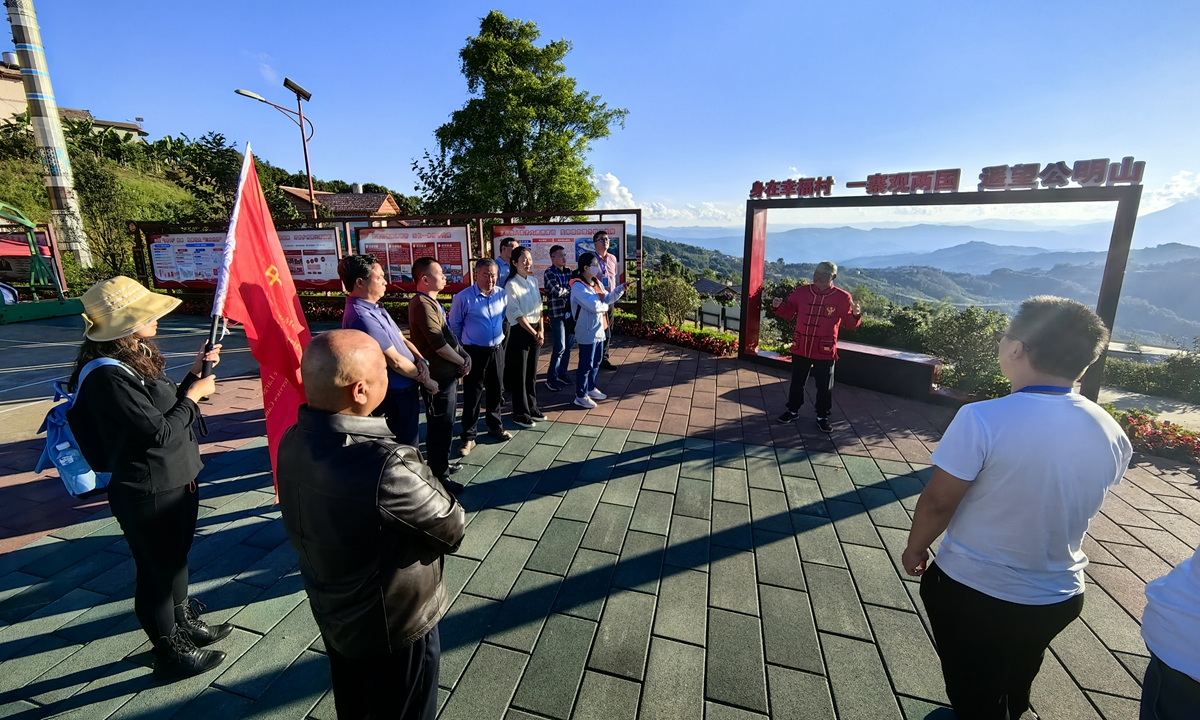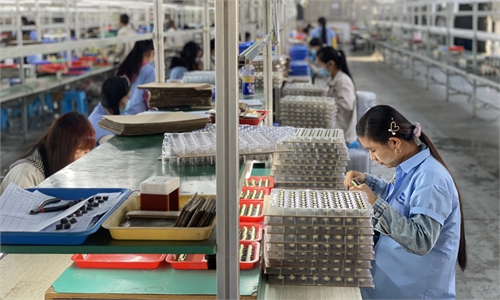Modernization of China’s border region with Myanmar brings mutual growth, aids in preservation of Wa ethnic culture
Fruits of development

A border village of Cangyuan Wa Autonomous County, Southwest China's Yunnan Province Photo: Courtesy of Zeng Qingzhou
Walking through the border villages along the China-Myanmar border in Lincang, Southwest China's Yunnan Province, one is greeted by traditional wooden houses, their intricate carvings and colorful decorations reflecting the rich cultural heritage of the local ethnic groups.
The last decade has witnessed the local government's great efforts in the governance of border trade, tourism, river and lake management, and ecosystem conservation, to create a prosperous rural model, while emphasizing ethnic unity.
In June 2019, Lincang took the lead in initiating the construction of modernized border villages. Today, 241 villages glitter like a string of beautiful pearls along the more than 290 kilometers of border in Lincang, lighting the southwestern border of China. The area has also received particular attention from Chinese President Xi Jinping.
In August, 2021, Xi encouraged veteran Party chiefs from border villages of Southwest China's Yunnan Province to play an exemplary role in leading villagers in building a beautiful homeland, maintaining ethnic unity, and safeguarding territorial integrity, the Xinhua News Agency reported.
Xi, also general secretary of the Communist Party of China Central Committee and chairman of the Central Military Commission, made the remarks in his letter replying to 10 veteran Party chiefs from nine border villages of Cangyuan Wa Autonomous County.
Xi said he was very glad to hear the country's poverty-relief drive has brought about profound changes for locals, and said he could feel the Wa people's faith and trust in the Party and the country.
In his letter, Xi said that eliminating poverty is a vital step toward better lives for the people, and he called for continued efforts to vitalize rural areas, boost development in border regions to benefit the people living there, pursue the common prosperity of all ethnic groups, and promote prosperity and stability in border areas.
Cangyuan, the county with the largest ethnic Wa population, has made remarkable progress in improving people's well-being since the 18th CPC National Congress in 2012. Locals now have better access to safe housing, drinking water, medical services and schooling.
By the end of 2019, all 40,000-plus impoverished people from the county's 67 poverty-stricken villages had shaken off poverty.
The Global Times found a group of Wa women sitting together and skillfully weaving bamboo baskets and other handicrafts at the central square of the village. The women work against a backdrop of beautifully adorned doorsteps, further showcasing their creativity and their diligent, harmonious, and joyful life as inheritors of traditional culture.
Villagers told the Global Times that local people have a common awareness that "ecological areas should be protected like our eyes."
The Nanlun River National Nature Reserve located in the middle section of the China-Myanmar border, for example, has a forest coverage rate of up to 93.8 percent.
Thanks to great efforts in habitat restoration and wildlife conservation in the reserve in recent years, previously endangered species such as the binturong and the Chinese serow can be found there. The calves of three Asian elephants have been monitored for four consecutive years, and multiple new plant species have been discovered, demonstrating significant achievements in biodiversity conservation.

Xiaba village in Cangyuan Wa Autonomous County on the China-Myanmar border Photo: Courtesy of Changjiang Water Resources Commission
A better environment
Guomen New Village in Cangyuan, which was built in October 2019, is a village on the mountainside with strong ethnic Wa characteristics. The refreshing and exquisite farmhouse courtyards attract many tourists who wish to experience the unique charm of ethnic culture and border village living.
In the village's Wa cultural square, the slogan "Observing Two Countries in One Village" is eye-catching.
Guomen New Village's chief, Bao Aibao, told the Global Times that the ethnic Wa people in China and Myanmar share the same ancestry, language, and customs, and maintain friendly relations. In recent years, many favorable measures in the village have driven the economic development of neighboring towns in northern Myanmar.
Cangyuan Wa Autonomous County, for instance, has made great efforts in recent years to plan and construct urban and rural water supply systems and consolidate the construction of water conservancy infrastructure in border areas in order to provide stable and clean water sources for both Chinese and Myanmar residents through cross-basin infrastructure, benefiting downstream residents in Myanmar.
"The new village has also planned to build a commercial and logistics special area and a border trade market. A centralized market can lower transportation costs and make business more convenient," he said. Bao used to do business on the China-Myanmar border, trading agricultural products such as konjac, coix seed, black fungus, and soybeans.
With the joint efforts from both China and Myanmar to combat rampant cross-border telecommunications fraud, more tourists now have confidence in visiting the villages along the China-Myanmar border, Bao said.

Guomen New Village's chief Bao Aibao (in red) introduces his village to reporters on October 26, 2023. Photo: Courtesy of Zeng Qingzhou
During the fieldtrip of the second Lancang-Mekong Water Resources Cooperation Joint Media Tour, foreign media reporters along the Mekong River countries highly praised the wisdom of China's border village water management and ecological conservation, and were eager to see such successes replicated in their own countries.Bao also said that despite of the recent armed conflict in northern Myanmar, border villages on the Chinese side have not been affected. The villagers have not heard any gunshots or sounds of fighting, partly because the Wa State across the border is not a focal point in the conflict.
Liu Yun, a research fellow at the Chinese think tank Taihe Institute, told the Global Times that the outbreak of conflict in northern Myanmar has limited impact on border villages in China. The response from the Chinese side mainly involved implementing preventive measures and increasing border patrols to ensure the safety and security of border areas.
Liu also noted that, in recent years, there have been positive developments in the governance of China's border villages. This includes the implementation of improved industrial policies and other measures. These improvements have had a ripple effect. As a result, there has been an increase in the number of people participating in cross-border trade and production activities.



